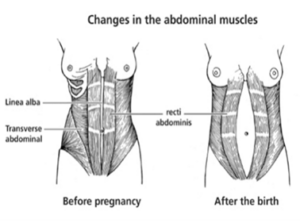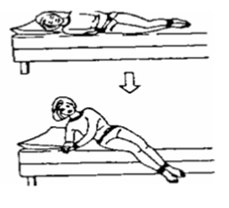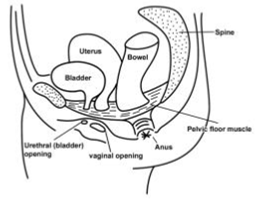Physiotherapy – Diastasis Recti following Pregnancy (DRAM)
Diastasis Recti following Pregnancy (DRAM)
This leaflet is to explain what diastasis recti is, what can cause it and how to manage it.
What is the rectus abdominis?
The abdomen is composed of four layers of muscle. The rectus abdominis muscle forms the top layer. It runs from the bottom of the ribcage down to the pubic bone of the pelvis. The two halves of the muscle attach together in the middle by connective tissue called the Linea alba.
What causes diastasis recti?
During pregnancy, the abdominal (tummy) muscles are stretched with baby’s growth and the linea alba gets softer due to the release of pregnancy hormones. This can cause thinning of the linea alba, resulting in a ‘diastasis recti’. See diagram:

Illustrated diagram of changes in the abdominal muscles
DRAM can affect both men and women, however it is more common in women during pregnancy or after birth. It is thought that some degree of separation is normal and expected in pregnancy, with up to 100% of women showing DRAM by week 35 gestation.
Signs and symptoms
Some of the symptoms you may notice might include:
- Doming or a bulge along the middle of the tummy, particularly when you sit up from lying down
- A gap between the middle of the stomach muscles
- Some discomfort along the middle of your tummy, especially if you have been more active
- Poor posture
- Lower back pain
- Symptoms of incontinence (leaking urine, stool/poo or wind)
- Symptoms of prolapse
When will these muscles recover?
Normally a small diastasis recovers within 4-8 weeks after pregnancy. However, a larger diastasis may take 6-12 months and requires input from a specialist physiotherapist to prevent long term problems such as back pain and incontinence.
Who is most at risk?
- Twin pregnancy / large babies
- Petite women
- Poor posture
- Poor abdominal muscle tone / strength
- Separation in previous pregnancy
- Obesity / being overweight
- Genetics
- Pregnancies close together
Things you can do to help
It is important to protect your weakened muscles. Try to avoid the movements that cause a ‘doming’ or ‘bulging’ of the abdomen. If you think you may have diastasis or have been diagnosed with one, here are some tips to help you manage and improve symptoms:

Illustration of getting in and out of bed
- Try to avoid sitting straight up from lying (doing a sit up). Instead, bend your knees so your feet are flat on the bed, roll onto the side you want to get out of. Bring your legs over the edge of the bed and use your arms to push you up into sitting.
- When lifting anything heavy or picking up your baby, try to keep your back straight, bend your knees and keep whatever you are picking up close to you. Squeeze your pelvic floor muscles and pull your tummy muscles in towards your spine as you lift. Try not to hold your breath as you do this.
- Avoid exercises such as sit ups, planks or crunches straight away, especially in the early days after your baby is born. Instead try to build up strength gradually by starting some gentle core exercises as detailed in this leaflet and increasing your walking tolerance.
- Introducing some gentle exercises like Pilates or Yoga are a good way of gradually building up strength after your baby is born.
- Try to avoid high impact exercises such as jumping or running until you are stronger.
- Avoid constipation by maintaining good fluid intake and a healthy balanced diet. Use a stool under your feet to improve your position when emptying your bowels.
Pelvic floor exercises
The pelvic floor is a group of muscles which lie like a hammock at the base of the pelvis, running from the pubic bone at the front to the tailbone at the back.
These muscles support the pelvic organs (bladder, uterus / womb and bowels) and help control the bladder and bowels. They work with the abdominal muscles to help support the spine and may also help with sex.

Illustrated diagram of pelvic floor
How to exercise the pelvic floor muscles
- Pelvic floor exercises should include long squeezes as well as short, quick squeezes, making sure you let go / relax the muscle between each squeeze. Aim to complete both long and short squeezes 3 times a day.
- Start by sitting in a comfortable position, feet flat on the floor, lying on your back or side with your knees bent.
- Imagine that you are trying to stop yourself passing wind. You want to feel the muscle around your back passage tightening and drawing upwards and forwards towards your tummy button. At the same time, if you can, think about trying to stop yourself passing urine (‘wee’).
- Try not to clench / squeeze the buttock muscles or hold your breath.
Long squeezes
- To begin, aim to hold the squeeze for 5 seconds. Let go. Relax for a few seconds.
- Repeat 5 times.
- As the muscle gets stronger, aim to hold for up to 10 seconds and up to 10 repetitions.
Short, quick squeezes
- Quickly squeeze the pelvic floor and then let go immediately.
- To begin with, aim to repeat 5 short squeezes. Make sure you relax the pelvic floor between each squeeze. As the muscle gets stronger, aim for 10 short squeezes.
You can download the NHS Squeezy app to help remind you to do pelvic floor exercises. Once your pelvic floor has returned to full strength, it is important to do both the fast and slow exercises once a day to maintain strength.
Remembering to exercise
It can be hard to remember to do these exercises routinely. Try to think of a good time in your day to do them so it becomes habit.
Use the NHS approved www.squeezyapp.co.uk available on all smart phones and mobile devices.
Remember to change the preset programme to the starting programme suggested.
Other important exercises – Abdominal exercises
The deepest abdominal muscles are called Transverse Abdominals (TA) and they work with other abdominal muscles and the pelvic floor to support your spine and help with good posture.
It is important to begin abdominal exercises by strengthening this muscle to begin with and this can be started postnatally as soon as you feel comfortable.
- Begin by lying on your back, knees bent, feet flat on the floor
- Find a neutral spine, back flat on the floor / mat, not arched or too tucked in
- Place the pads of your fingers firmly over the lower part of your tummy (about an inch above your pubic bone)
- Take a breath in feeling your tummy muscles rise.
- As you breathe out, keeping your back relaxed, draw your lower tummy muscles in from your belly button towards the spine.
- You may feel the muscles tighten under your fingers.
- Keep this contraction while you take another 2-3 gentle breaths in and out.
- Fully relax / let go of the contraction.
Once you are happy with this exercise, you can try this in different positions such as lying on your side, on your hands and knees, sitting and/or standing.
1. Abdominal Muscles Exercises
Begin gentle abdominal exercises postnatally when comfortable.
Lying on your side –
Place your hand on the lower part of your tummy, to feel your muscles working. Gently tighten – hold for 3 secs and then relax. Repeat this action 8-10 times, 3 x day.
2. Dynamic Sitting
In sitting – ‘Squeeze and lift’ the pelvic floor, at the same time, draw in your lower tummy slightly harder than the exercise above (1). Hold for 5 seconds while you breathe out. Relax, and then repeat 8 times. Gradually increase the time you hold the muscle in. Your physiotherapist will guide you further with this exercise.
3. Pelvic Tilts
This is a great exercise to begin strengthening your abdominal muscles, helping with posture, and easing low back pain.
- Begin by lying on your back, knees bent, feet flat on the floor.
- Engage your lower tummy muscles (as above) and contract your pelvic floor muscles at the same time.
- Flatten your back into the floor / bed, allowing your pelvis tilt/roll upwards and towards you
- Hold for 3 seconds, then gently release. Repeat up to 10 times, 3 times a day.
When to seek help
Remember symptoms of a diastasis are common, they are not normal and should be addressed. See your GP, midwife or health visitor and ask them to refer you to Pelvic Health physiotherapy service.
Further Resources
For further information, diagrams of these exercises and further exercises, please visit:
There is helpful information under the Pregnancy and Postnatal section or more detailed information booklets can be downloaded –
- ‘Fit for the Future’
- ‘Exercise after Pregnancy’
This information and guidance is available in many different languages using the ‘ReciteMe’ function of the www.thepogp.co.uk website.
There is also more information to support your postnatal recovery on
Contact us
For the Luton team based at Chaul End, call 01582 329 638
For the Bedford team, call 01234 792673
Alternatively, use this QR code to access the Trust resources mentioned above:

QR code leads to pelvic health section of Trust website
